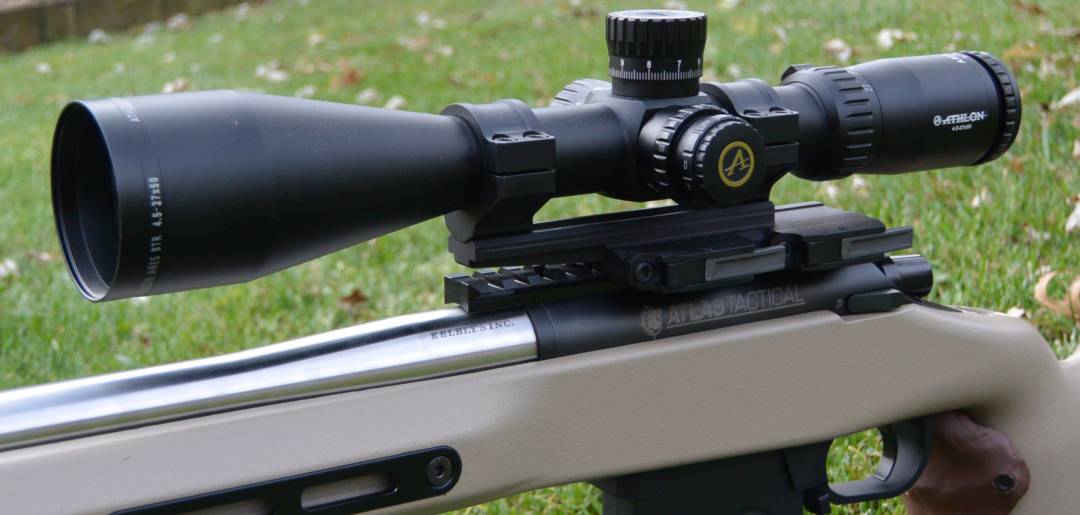
Athlon Ares BTR 4.5-27x50mm on Mesa Precison Arms Crux
Table of Contents:
– Background
– Unboxing and Physical Description
– Reticle
– Comparative Optical Evaluation
– Mechanical Testing and Turret Discussion:
– Summary and Conclusion
– Testing Methodology
Background:
Athlon is one of the newest players in the sport optics industry and it turned some heads a few years ago as it seemed to be born, fully formed, with a complete line of scopes at a wide variety of price points. This is because, in some respects, the apple doesn’t fall far from the tree, or runner, depending on your metaphor (I know, stretching it). Athlon was founded by (and is still run by) some Bushnell alums. As such, Athlon had the experience and contacts of a major market player at its start. Its business model also essentially differs little from that of its parent. They are both importers and brands – not manufacturers. As with most importers, they offer a broad selection of product lines and price points sourced from a variety of OEMs.
Where Athlon departs from many of the importers, or at least from its parent, is that it is smaller, more nimble, and flatter in terms of corporate organization. The principal players of Athlon are on the floor at tradeshows talking to customers, industry players, and grumpy writers. This is not really a large or small company thing so much as a philosophic thing. Huge companies, like Kahr or Benchmade for instance, can, and do, have founders on the floor. Much smaller and more bureaucratic companies often do not. This shows in the timeliness of the features Athlon puts in scopes: they have their ear to the ground. My take is that the plan is basically to win on three things: cost, service, and up-to-date feature sets. So far they appear to be mostly delivering on these points. Athlon scopes are generally less costly than other brands coming from the same OEM, they seem to be building a solid reputation for customer service, and their features are up to date with market trends.
Unboxing and Physical Description:
Unboxing the Athlon Ares BTR 4.5-27x50mm reveals it to be pretty sparse on the accessories: no caps or covers, just a lens cloth, battery, manual, and invitation for the customer to review the product online. I think I’ll do that.
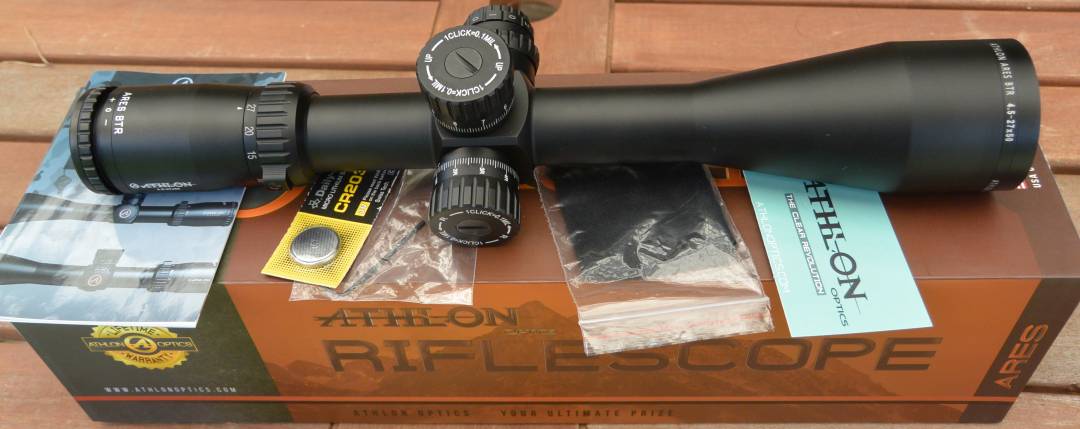
The scope itself is on the smaller side for this magnification range. It features a mid size 50mm objective and is 13.8″ and long, 27.3oz. I am a fan of smaller objective, lighter weight optics. I have the general opinion that traditional objective sizes have never adjusted to the incredible light transmission gains that current generation lens coatings have made possible and this has left many scope makers manufacturing huge, heavy, scopes that gain little additional low light capabilities for all that added weight.
The adjustments on the Ares have a pretty good feel. The power ring and euro style diopter are on the looser side with the parallax and illumination on the stiffer. As it comes, the elevation and windage knobs are on the mushier side of average with clicks that are tactile but not audible (as if any clicks would really be audible at a shooting range with hearing protection on). However, the adjustments have an o-ring that is user removable and unnecessary for sealing the scope but which can be removed to change the adjustment feel. Removing this results in an adjustment that takes less force to move but has clicks that are audible and feel more defined. Many prefer this feel. The elevation knob is 10 mil per turn and features both a zero stop system that is a little different from what I have seen before and markings that can be repositioned. Repositioning the markings is done in a common way. They are located on an outer sleeve that pops off after removal of a screw. This sleeve is toothed with enough teeth that its markings will properly line up with the actual detents instead of landing between as some others have done. The zero stop system is not one I have seen before and I am embarrassed to admit that I did not even notice that the scope had one until halfway through the review. As is common, the whole elevation knob on the Ares screws up and down as the adjustment it rotated. This attribute forms the basis of both the zero stop and the simple scribed turn indicator. The zero stop consists of a brass disc they refer to as the “zero stop locking plate” located under the removable outer adjustment sleeve. This disc can be repositioned using three set screws. So, basically, you zero the scope, remove the outer sheath, loosen the set screws, and move the disc so that it is lying flat on the saddle with its stop protrusion immediately to the right of the stop protrusion on the scope saddle. You then gently tighten the set screws and replace the sleeve and its screw with the proper alignment of the zero. This zero stop is very inexpensive to make in addition to being quite functional. It also has the same advantage as most plunger style systems in that you can set it independently of the markings to give you a few tenths of adjustment below the zero if you want. It is a well designed system and I’m a fan.
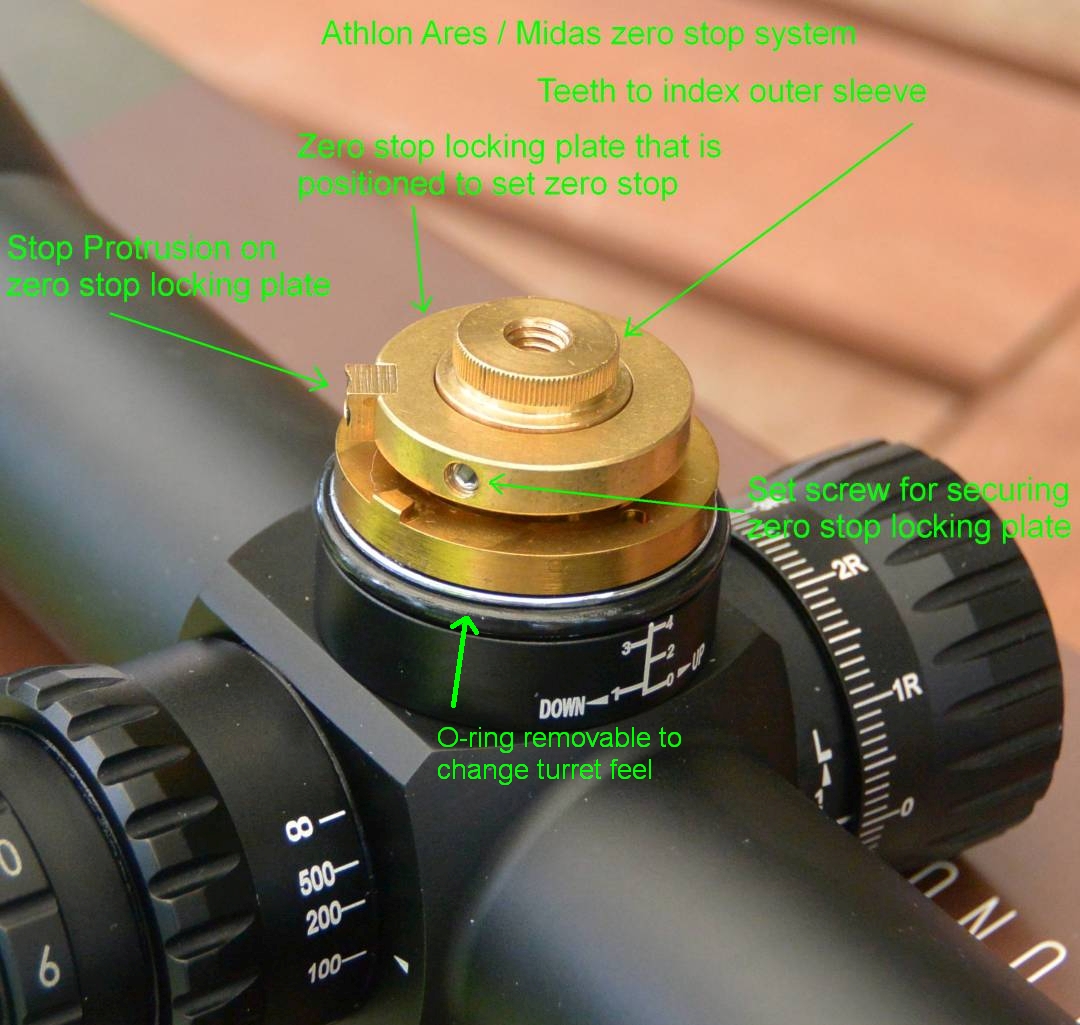
The manual included with the Athlon scope is a mixed bag. It includes pretty good sections on focusing, setting eye relief, bore sighting, and zeroing (although it mistakenly refers to the “zero stop locking plate” as black when it is actually brass) and a lesser section on mounting. It also has some nice dimensioned diagrams of each reticle in the line. The section on troubleshooting tips for accuracy is problematic, however, as it has some poor enough advice in it that I am writing about it. The section advises the shooter to “use a bench rest or sandbag to support the barrel and stock”. Force on the barrel deflects the barrel, causing shots to stray and should be avoided – not encouraged – when seeking to shoot with accuracy. Support of the barrel with sandbags is actually often the cause of inaccuracy and not a solution for it. The manual also says to make sure there is “no excessive grease inside of the barrel”. This suggests to me that there might be a good reason to have a proper amount of grease in the barrel and a novice shooter might then, in error, apply grease to such. Though grease is sometimes used in a barrel for long term storage, there should never be any grease in a barrel when you are shooting. Grease in a barrel can not only cause inaccuracies, but can also cause dangerous and/or unbalanced pressures in a barrel. Grease does not protect a barrel from wear either, as wear is overwhelmingly a product of erosion in the throat of a barrel from powder burning there and not a product of friction with the bullet over the length of the barrel.
Reticle:
Unsurprisingly, for a scope designed to be cost conscious, there is only one mil and one MOA reticle. They call both of these APLR3 reticles and they are similarly styled. The mil one used in this review has .2mil graduations pretty much all around including a cleverly done integration of a floating center crosshair to that scheme. Floating centers seem to be the current trend. The reticle is on the finer side of average, which I like, and has a substantial Christmas tree section with .2 mil graduations left and right every 1 mil of elevation that is a bit busier than I prefer. The biggest thing I am having trouble coming to terms with on the reticle is the ticks between each mil being only up for the first two and down for the second two with the actual mil divisions being both up and down. I get the logic but am not finding it quite as fast and intuitive in practice as I would like. All that said, it certainly has the features and advances of the most popular reticles today and I expect the reticle to be well-liked – at least as well-liked as anything can be when it comes to the personal taste that comes into play when talking about reticles. A tremendous amount of how much a reticle is liked by a shooter comes down to what that shooter is already comfortable with and therefore finds intuitive rather than any better or worse practices and all of the things I am picking about with the APLR3 are in that former ‘taste’ category. Most importantly, when tested, the reticle showed no deviation in size from the correct dimensions and also showed no cant relative to the adjustments.
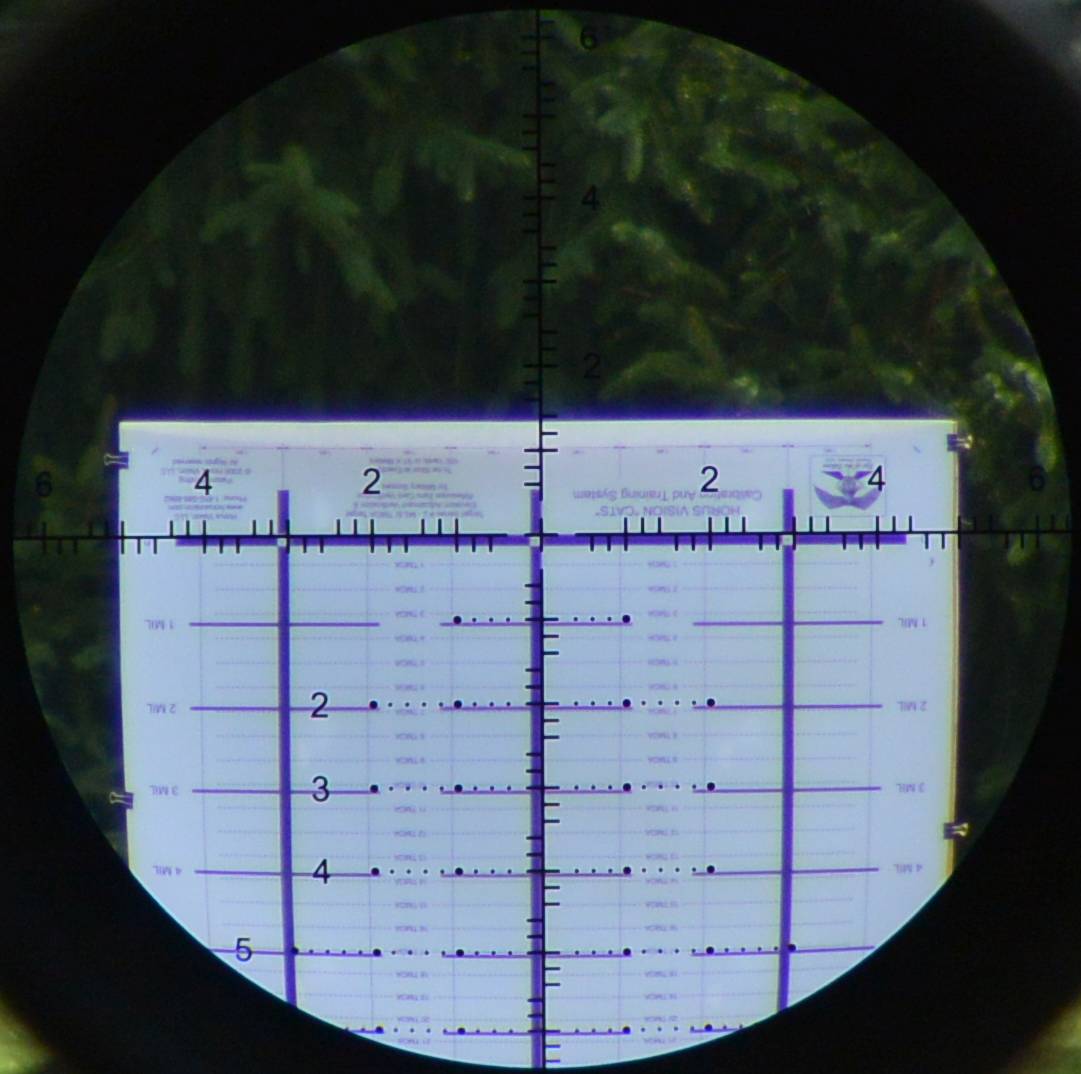
Comparative Optical Evaluation:
For optical comparisons to this Athlon Ares BTR 4.5-27×50 FFP IR Mil, I had the other scopes in this series of sub $1K FFP mil/mil precision rifle scope review, the Athlon Midas TAC 6-24×50 mm and Sightron SIIISS624x50LRFFP/MH, as well as two that have been used as comparisons by me in previous reviews for context, the Leupold Mk 6 3-18×44 and my old (and now discontinued) Zeiss conquest 4.5-14×44. All of these scopes were lined up together on a five slot adjustable v-block and evaluated using the procedure outlined in the methodology section at the end of this review. This same methodology is used on all long range scope evaluations and has been for several years now.
I have never before had a set of five scopes with such generally close optical performance. Usually, scopes somewhat sort themselves into performance tiers with higher tier scopes being better than lower tier scopes in pretty much all characteristics. That was not even remotely the case with this lineup. No scope was always first or last when evaluating particular performance parameters and the order of the scopes’ rankings changed with pretty much every particular parameter being evaluated. That being said, the Ares was, on balance, on the better side of average for the group. Its best showings were resolution, low light performance, and eyebox, where it was second best in the lineup to two different scopes. Weak points were in distortion, where it had noticeable barrel distortion, and field of view, where it was probably the narrowest, but at least certainly on the narrow side, though this is difficult to be sure of as power ring markings are not actually calibrated. Other aspects where the scope scored mid pack, such as stray light handling, contrast, depth of field, and chromatic aberration were better than I expected at the price and should not be of issue to any shooters. Edge to edge clarity was excellent on all the scopes tested and no scope displayed any tunneling.
Overall I found the Ares performance quite satisfactory – much better than I expected at the price and far better than I saw a couple years ago in significantly more expensive and less feature rich competitors. The Ares, and in fact all of the sub $1K scopes in this lineup, land solidly in what I consider the mid-range performance tier that I formerly most associated with $1.5-2K price range optics. It should be noted here that the Athlon Ares BTR 4.5-27×50 has a massive 6x erector ratio. It shares this ratio with only the many times more costly Leupold Mark 6 in this group. The other scopes had 4x and 3.1x ratio erectors. That large erector ratio significantly complicates design and makes optical performance more difficult to obtain. It is also not something you expect to see in a sub $1K optic. This sort of erector range is usually associated with scopes $2K and up. To see it executed this well in scope of this price is surprising. I will admit to having the false expectation before starting the review of this scope having a lot of optical difficulties and finishing near the bottom of the group instead of on the better half of average.
Mechanical Testing and Turret Discussion:
As mentioned in the unboxing section, the Athlon Ares BTR 4.5-27×50 FFP sports a very feature rich 10 mil per turn zero stop elevation knob where the zero stop and zero are set independently allowing you to set whatever amount of turn below the zero before the stop that you desire. The elevation knob is also 10 mils per turn and very similarly constructed but lacks a stop and is marked in L and R instead of continuously. Testing the accuracy of these adjustments was done in accordance with the methodology section detailed at the end of this review. This methodology was followed on all the scopes this year and has been in use for a few years now.
In testing, the adjustments deviated from the proper magnitude in the following ways and degrees:
Adjusting impact up from optical center, the scope slowly lost a little for a little while.
At 5.9 mils on target it reads 6.0 on the adjustments.
From that point on, it was constant – adjusting to a maximum of 12 mils on target reading 12.1 mils on the knob.
Adjusting down from optical center, the scope showed no deviation 8.5 mils down to my zero stop with about 5 mils beyond that for a total elevation travel that is probably a little more than the stated spec of 22.2 mils.
Similarly excellent, the windage tracked cleanly out to 4 mils each way.
Tracking on both adjustments was repeatable and the scope returned to zero with no problems. The windage and elevation were also properly independent. No zero shift was affected by power change, parallax change, or diopter change.
I was quite pleased with the almost negligible deviation in adjustment magnitude shown by this scope in testing. Getting adjustments to exactly match the correct magnitude is one of the most difficult aspects of scope manufacture. As such, most scopes show deviation to some degree measurable with my equipment. The average deviation for high-end scopes, based on my past tests, is about 1%. On average, this scope was better than that over its total range and at no point was off by more than one click. You really can’t ask for better than that.
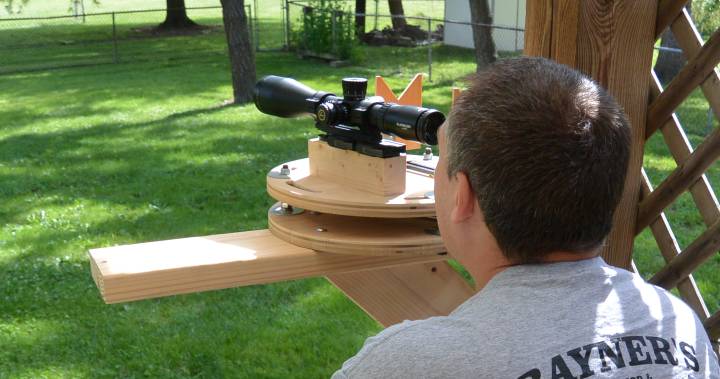
Summary and Conclusion:
What would you pay for a mil/mil ffp scope with 10 mil per turn turrets, illumination, a solid lifetime warranty, 6x erector ratio, zero stop, and good glass? I can tell you what you wouldn’t have paid a few years ago was the $850 street the Ares goes for. You would have paid at least twice that. I can’t tell you in the long run how this scope will weather. Athlon is basically a brand new brand so its track record, though good, is very short, but I can tell you that my first experience with their products has been quite good. Both of their scopes exceeded my expectations optically, mechanically, and with regards to feature set. I should also mention, since it is coming close to Christmas and it is unlikely that the Midas TAC review will be posted before then, that the performance was very close between the two models (the Ares optics are a little better but not much) and given that, and some similarities in manufacture, I expect both models come from the same Chinese OEM. So, your preview on that review is that those looking to choose between the two are debating price for features as the quality appears quite close.
In the larger picture, the takeaway I am having from these sub $1k ffp mil/mil reviews is that you can get a whole lot more now at this limited budget than you could before. In fact, I think these lower cost options are going to start to lure a lot of folks from higher price tiers who are willing to give up a little optical clarity, field of view, and sometimes power range, for a scope that is a lot lighter and a lot cheaper.
Here is Your Pro and Con Breakdown:
Pros:
– Optics are good, better than I expect at the price
– Tracked very well with no zero shifts
– Properly sized reticle with no cant
– Very simple effective zero stop that lets you chose travel below zero
– Big 6x erector ratio usually only seen on much more expensive optics
– Lightweight, 27.3oz
– Smaller 50mm objective I prefer
– Full 10 mil/turn knobs
– Good adjustment range, 22.2mil
– Illumination
– Reticle design in line with current trends
– Good warranty
Cons:
– Field of view on the small side
– Basically no extras like scope caps, sunshade, or bra
– Athlon is a new company with a good, though very short, track record
– Manual has some advice that may lead a novice astray
